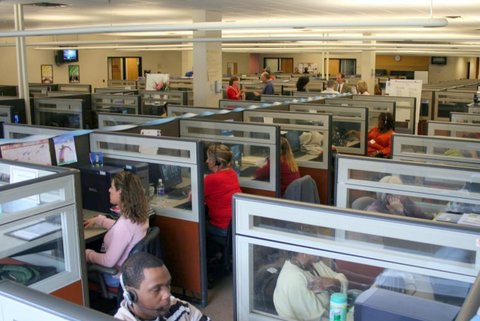Five Contact Center Trends to Follow in 2017
 “The easier it is to get fast, convenient customer service, the more consumers will engage with customer service. That higher level of engagement will remain essential to building the long-term loyalty that businesses depend on for stability and continued growth.”
“The easier it is to get fast, convenient customer service, the more consumers will engage with customer service. That higher level of engagement will remain essential to building the long-term loyalty that businesses depend on for stability and continued growth.”
A new year means new possibilities. Since your looking to improve your contact center this year, let’s examine the trends driving our industry now. Here are some “hot button” issues that forward-thinking contact center professionals will be facing in the next few years.
First, the very good news for the industry at-large: we are growing. A recent Forester Research report found that, more than ever, consumers are reaching out to customer service organizations. They’re using every channel available to them, including video chat, Facebook Messenger, WeChat, Twitter, online communities and other services. In fact, the easier it is to get fast, convenient customer service, the more consumers will engage with customer service. That higher level of engagement will remain essential to building the long-term loyalty that businesses depend on for stability and continued growth.
As a result, many customer service organizations are spending more money on staffing. Forrester’s data shows that “51% of contact center decision-makers project their contact centers to grow in size as measured by number of agent seats by 5% to 10% next year, and 13% project a growth of more than 10%.”
Forrester cautions that adding agents isn’t the cure-all for handling higher contact volume. Which brings us to our first hot trend for 2017 and beyond.
Trend #1: Self Service and Digital Engagement
As the number and variety of customer service channels increase, customers are using self-service more frequently. Self-service can offer significant ease and speed when it comes to resolving less complex issues. Contact centers “must make the move to self-service and digital engagement smartly and keep customer expectations for service squarely in their line of sight.”
Forrester analyst Kate Leggett adds “customers don’t want to wade through a laundry list of answers; they want self-service sites to serve up the one right answer to their question.” Businesses have to up their knowledge management programs to make information easy for agents to find and put into context with the customer’s request. “They must use modern knowledge solutions with learning and analytics to measure and optimize the value of content.”
Trend #2: Open Up Low Friction Channel
Forrester’s data also found that, when it came to choosing customer service channels, “in the past 12 months, 84% of US online consumers used web and mobile help or FAQs, 83% used the phone, 76% used email, 65% used chat, 56% used communities, and 43% used Twitter.”
The popularity of Web chat is expected to rise because it is a “low friction” way to interact with an agent. Forrester notes that in the US, the number of adults using online chat for customer service has boomed in recent years, up from 43% in 2012 to 65% in 2015. “Organizations can quickly connect customers to an agent with the right skills to answer the question without them having to navigate an arduous interactive voice response (IVR), they can succinctly resolve questions in near-real time, and agents can leverage customer behavior on the website to move the conversation forward instead of rediscovering information that has already been communicated to the customer.”
The way consumers use the phone is changing fast, too. Customers are now more likely to try to resolve service issues using self-service or web chat, but they still prefer live agent interactions to solve complex issues or requests.
This means that although the rate of telephone usage has dropped dramatically as the first point of contact, live agents must be equipped to perform at their absolute best, providing the clarity, ease and simplicity that consumers are demanding. That’s why this third trend may come as a surprise.
Trend #3: Higher Levels of Service From Contact Center Live Agents
Live agents are becoming more important than ever when it comes to building and nurturing customer relationships. The use of technology in the contact center has actually created a greater need for well-trained live agents with excellent soft skills. (If your agents need to improve their soft skills, take a look at our online training program.)
A 2015 article in the Harvard Business Review stressed that the need for soft skills will continue to grow. In fact, nearly all job growth in the US since 1980 has taken place in sectors that require solid social skills. Researcher David Deming found a simple reason for this: computers are bad at simulating social interaction.
There’s no doubt that computers are becoming more agile, but there’s still a very long way to go before artificial intelligence will replace humans in the contact center – if ever. Emotional intelligence and the ability to develop and refine interpersonal skills are purely human – and an absolutely essential part of a well-rounded agent’s skill set.{{cta(’98f38b19-1371-4c85-aeb1-0d6d520286d6′)}}As consumers have been given more contact channels to choose from, they’ve been gravitating to the easiest, most direct path to the information they want, and that’s not going to change. They expect to find answers that are relevant, complete and as uncomplicated as possible on demand. That’s why consumers expect customized experiences from the live agents they interact with.
In addition to speaking to someone who listens well and communicates clearly and who doesn’t waste their time with meaningless or redundant conversations, consumers expect live agents to have thorough knowledge of their account.
Trend #4: Knowledge and Speed in the Contact Center
Because consumers will be using self-service and low friction channels as their first path to rapid, accurate information, expect them to insist on a higher level of speed and knowledge from live agents. If they can’t get an answer through zero-touch methods, consumers will push past that level of frustration to speak to a person. Realistically or not, those customers will look for an above and beyond service experience at that point.
This underscores the need for innovative training and coaching programs to address any gaps in hard or soft skills agents may have. Keep in mind that, no matter what your center’s ASA goals are, the person calling in wants to be cared for as quickly as possible.
Trend #5: Higher Levels of Professionalism (see trends 3 &4)
Increased demand increases tension in the contact center. Supervisors, managers and agents must be able to navigate complex questions with care, enthusiasm and empathy while keeping the company’s business objectives at top of mind. It’s a lot to juggle on the best of days. Customer service organizations must invest in training and ongoing professional development to survive.
 “If you haven’t addressed these trends you’re already behind the times.”
“If you haven’t addressed these trends you’re already behind the times.”
Big Changes Are Coming to Contact Centers: Here’s How To Prepare
There are several aspects of the market that we expect to change dramatically over the next three to five years. But before we dive in to market shifts, let’s take a quick look at the potential dollars and cents impact of great – and not so great – customer service on our economy.
The economic benefits of customer service can be measured in three ways:
- the willingness to buy again,
- how likely a customer is to abandon you for a competitor,
- and how likely a customer is to recommend your products or services to their network of family, friends and colleagues.
According to a recent Forrester Research report, Transform the Contact Center for Customer Service Excellence, “the revenue impact from a 10-percentage-point improvement in a company’s customer experience score can translate into more than $1 billion.”
The same report offers some sobering data on the costs of poor customer service.
- 53 percent of adults making online purchases in the US will abandon the sale if they can’t find a quick answer to their questions
- 69% of these consumers move to another channel when online customer service fails
- The necessary service costs for online retailers due to channel escalation are estimated to be $22 million on average.
- Of 2.5 million customers who say they are unlikely to come back to a site that doesn’t offer great service, only 2 percent complain to the contact center. Forrester estimates that at $100 apiece, this lack of action costs retailers $250 million a year in lost revenue.
The barriers to providing a great customer experience that companies will be struggling with in the immediate future include:
-
Access to data
As Forrester put it, “customer service agents often use multiple disconnected applications when resolving a single customer issue. This lack of a standardized discovery process hinders agent consistency and productivity, increases agent training times, and leads to a higher level of agent turnover due to frustration with the tool set.”
-
Compliance
As regulations become more complex in finance and healthcare, Forrester found that “few real-time processes in customer service organizations audit agent actions against policy requirements, leading to higher service costs due to incurred penalties.”
-
People
“Today, customers resolve straightforward customer service interactions via self-service, leaving complex issues like account closure, booking a complex multicity set of flights, or an explanation of smart metering billing policies for a phone conversation,” writes analyst Leggett. “These questions often take longer to resolve and are opportunities to build positive customer relationships with an end goal of increased customer loyalty. They also demand a higher caliber of agent for effective issue resolution.”
-
Process
The rise of blended departments and shared duties and roles will require tighter controls on process management. As customers embrace self-service options more fully, expect the focus on first call resolution and next call avoidance to become paramount.
-
Technology
On the consumer side, service apps are popping up every day. From telematics in insurance and healthcare to virtual agents that can find fast remote answers, customer service apps will continue to flood the marketplace.
On the contact center side, self-directed coaching and training apps will gain in popularity. Center managers benefit from improved analytics on the floor, and corporate marketing managers can gain faster, more accurate insights and improved process management through predictive analytics.
-
Workforce management
The days of using spreadsheets are over, or they should be if you’re serious about the success of your service operation. Investing in tools to optimize your workforce management can help contact centers save money through more precise scheduling, better resource management, and the availability of robust analytical tools.
-
Better case management
Many firms have yet to integrate the customer data that they collect at from phone, email, chat, and web self-service. This failure leads to inconsistent service, which raises the cost per transaction as well as decreasing customer satisfaction rates. Expect this to change rapidly over the next few years.
In conclusion, there’s another big trend that we’ve seen, and the researchers at Forrester agree:
NOT ENOUGH COMPANIES OPTIMIZE THE SERVICE EXPERIENCE
Forrester describes the optimized customer service experience as a win-win. “Customers are satisfied because companies deliver service efficiently, in line with expectations. Companies are satisfied because they contain costs, as this type of service minimizes handle times and customer re-contacts and maximizes first-contact resolutions.”
So why don’t companies deliver the level of attention that consumers want and the customer capture and retention rates that their bottom lines depend on? One of the biggest reasons is lack of bandwidth: effective contact center administration and management is multilayered and extremely complex.
Outsourcing is an excellent option for firms ready to face the future. The right contact center vendor will meet and exceed the highest deliverables, and have the resources, expertise and management ability to ensure your service operation excels.
At GCS, we have the services, tools and intelligence to get you ahead of customer experience trends. We don’t just hire the brightest agents – we hire nice people who are temperamentally fit for customer service and train them in the hard and soft skills they need to succeed.
You don’t have to overhaul your existing center to develop one of your greatest assets – your agents – we have an innovative, intuitive online training and coaching program to help build and reinforce interpersonal skills. It’s making a difference at centers around the country right now, and it can be that valuable assist your managers need to improve your center’s performance. You can access a demo of Say This… Not That, Most of the Time, here.
We have the people, processes and technology that can make your contact center more productive, effective, efficient, and we’re here to help you reach your most ambitious goals. Together, we can leverage these industry trends to satisfy your customers and meet your revenue requirements.
Request more info today
Tell us about your program and we'll get back to you ASAP.

